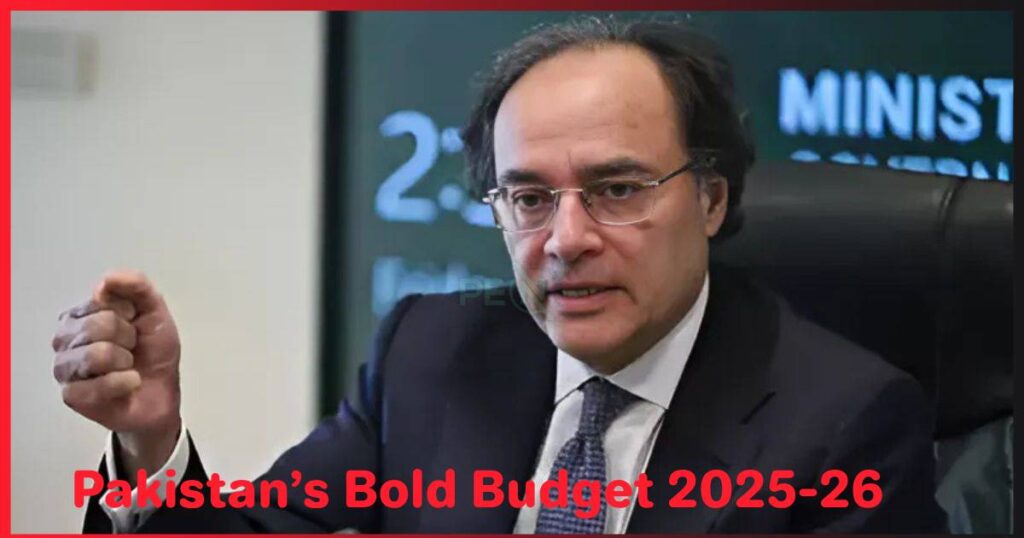Pakistan unveils its FY2025-26 federal Budget 2025-26t on June 10 with bold reforms in tax simplification, SOE privatization, and export-led growth. Finance Minister Aurangzeb outlines a $3 trillion economic vision by 2047.
As Pakistan prepares to unveil its federal budget for the fiscal year 2025-26, Finance Minister Muhammad Aurangzeb has signaled a transformative shift in the country’s economic direction. Speaking at an event organized by Karandaaz Pakistan and the Pakistan Banks Association (PBA) in Islamabad, the finance minister laid out a comprehensive fiscal roadmap that emphasizes bold reforms, structural transformation, and strategic economic planning.
Table of Contents
Strategic Budget 2025-26 to Break Away from Traditional Models
Aurangzeb made it clear that the upcoming budget will not follow the conventional approach of balancing revenue and expenditure alone. Instead, the finance ministry is aiming to turn the budget document into a strategic blueprint that guides long-term economic policy and ensures sustainable development.
“We are going to bring some bold measures during the budget for FY2025-26,” said Aurangzeb. “This budget will be more than just math—it will reflect a broader economic vision.”
The federal budget is scheduled to be presented on June 10, 2025, with the Pakistan Economic Survey 2024-25 being released a day earlier on June 9, 2025.

Focus on Export-Led Growth
The finance minister highlighted the government’s commitment to shifting from consumption-led growth to export-oriented development. According to Aurangzeb, Pakistan’s economy has already surpassed the $400 billion milestone, and the international community is recognizing the country’s macroeconomic stability.
“Export-led growth is essential to escape the boom-and-bust cycles that have historically plagued Pakistan’s economy,” he added.
Key Structural Reforms in Focus:Budget 2025-26
The budget will focus heavily on structural reforms in three primary sectors:
- Taxation: Simplifying the tax filing process, especially for salaried individuals. The number of steps required to file returns is being reduced dramatically from 140-150 to just nine steps, with full implementation expected by September 2025.
- State-Owned Enterprises (SOEs): Accelerating the restructuring of underperforming public enterprises, including a renewed push to privatize Pakistan International Airlines (PIA).
- Energy Sector: Reforms to improve efficiency, reduce subsidies, and ensure long-term sustainability.
Aurangzeb acknowledged that SOE reforms lagged in the past year but reaffirmed the government’s dedication to fast-tracking the process.
Right-Sizing the Government:Budget 2025-26
The finance minister also underscored the importance of reducing the size of the federal government to streamline operations and reduce expenditures. Right-sizing is being positioned as a cornerstone for ensuring sustainable fiscal management.
“We are focusing on making the federal structure leaner and more efficient,” said Aurangzeb.
Debt Management and Fiscal Stability
In a significant development, government debt servicing costs have reportedly decreased by Rs1 trillion during the current fiscal year. The government plans to restructure and modernize the debt management office to further enhance efficiency and accountability in debt handling.
IMF Talks and Global Engagement:Budget 2025-26
Amidst ongoing negotiations with the International Monetary Fund (IMF), the minister confirmed that despite external efforts to derail talks, Pakistan’s economic case has been judged on merit. The IMF concluded its 10-day discussions on Pakistan’s 2025-26 fiscal budget without a formal agreement, though discussions are set to continue.
“Attempts were made to block our meetings with the IMF, but ultimately our case was discussed and decided on merit,” noted Aurangzeb.
The IMF mission, initially scheduled for May 13–23, had to start remotely from Turkiye due to escalating India-Pakistan tensions. In-person meetings were later held in Islamabad starting May 19.
According to Nathan Porter, the outgoing IMF Mission Chief to Pakistan, the discussions mainly revolved around improving tax compliance, expanding the tax base, and rationalizing government spending.
Delay in Budget Presentation Due to Diplomatic Engagements
The government had originally planned to present the budget on June 2, but it was postponed to June 10 to accommodate Prime Minister Shehbaz Sharif’s diplomatic tour. The prime minister is visiting several nations to extend gratitude for their support during recent geopolitical tensions.
Long-Term Vision: $3 Trillion Economy by 2047
Aurangzeb outlined an ambitious vision for Pakistan to become a $3 trillion economy by 2047. However, he stressed that this long-term target requires urgent action on two critical fronts:
- Population Growth: Managing the rapidly increasing population to reduce pressure on resources and public services.
- Climate Change: Adopting green policies to combat environmental degradation.
He referenced the recently signed 10-Year Country Partnership Framework with the World Bank, where four out of six priority areas directly address climate and population issues.
Political and Military Unity Amid Tensions
The finance minister praised the unity displayed by Pakistan’s armed forces and political leadership during recent tensions with India. He urged for similar unity in confronting the country’s economic challenges.
“The same unity we have seen during times of aggression must now be applied to our economic front,” Aurangzeb declared.

Conclusion: A Pivotal Moment for Pakistan’s Economy:Budget 2025-26
The 2025-26 federal budget could mark a significant turning point in Pakistan’s economic history. With bold reforms, a strategic outlook, and a commitment to long-term sustainability, the government aims to steer the nation toward stability and growth.
While challenges remain—especially in terms of IMF negotiations, geopolitical tensions, and internal structural inefficiencies—the intent to modernize and reform is evident. If executed effectively, the budget could serve as a blueprint for economic resilience and transformation.
As Pakistan approaches budget day on June 10, all eyes will be on how these ambitious plans are translated into actionable policies that can uplift the nation’s economy and improve the lives of its citizens.




